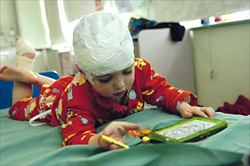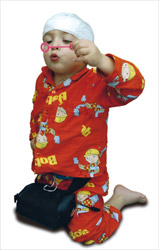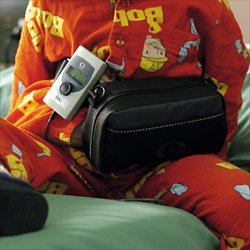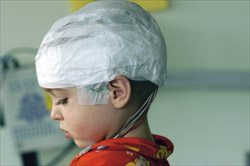Watch the RCH video: A child's guide to the hospital - VEM
What is Video EEG Monitoring (VEM)?
Video EEG Monitoring (VEM) is a way of simultaneously recording a child's behaviour and brain electrical activity (EEG). It is done with special equipment which records EEG, video and sound onto a computer for later analysis. In contrast to routine EEG recordings which are normally performed between episodes, VEM aims to record a child's EEG and behaviour during episodes.
Why is VEM performed?
The main reasons children undergo VEM are:
- to distinguish epileptic seizures from episodes that may mimic epileptic seizures
- to characterise the type or types of seizures that a child is having
- to localise the part of the brain from where a child's seizures are arising (in this setting, VEM is sometimes performed with SPECT)
Where is VEM performed?
Inpatient VEM is performed in the Epilepsy Monitoring Unit on
Cockatoo Ward at The Royal Children's Hospital, where children with neurological and neurosurgical conditions are nursed.
How long does VEM take?
The duration of VEM varies from a few hours in one day to continuous monitoring over many hours for a week, depending on how often your child is having seizures. Generally, we like to record 2 or 3 typical seizures. If your child has different types of seizures, we like to record examples of each if possible.
What do children do during VEM?


Children will need to stay in bed or in a chair, in constant view of the camera at all times. This includes during meals, sleep and play. The camera can be turned away during bathing and toileting for privacy. Sometimes it may be possible for your child to use the ward bathroom facilities off camera.
We realise that restriction of activity may be difficult for some children. A limited number of play and school activities are available in the ward and each bed has a television.
Toys, books, school work, battery operated games and portable radio/CD players that can be used in the limited space of the ward can be brought along. For school age children, we recommend that you bring school work to try and mimic normal daytime activity.
What is the parent or carer required to do during VEM?

A parent, adult relative or carer needs to be with the child at all times during VEM. VEM usually requires 2 people to be available to help with monitoring during the day and night. Please discuss this with your child's neurologist or with the epilepsy nurse specialist, prior to admission.
The attendant (parent, adult relative or carer) is required to:
- Press a seizure button, record on a sheet of paper, and occasionally report to staff the time and type of seizures. The attendant therefore needs to be familiar with the child's seizures.
- Help keep the child occupied and on camera, often the most difficult part of VEM.
The Epilepsy Monitoring Unit scientists and nursing staff will demonstrate the video-EEG recording equipment when the VEM is set up.
If only one attendant is present, nursing staff will organise for someone to observe the child while he/she takes a short break. If you are staying overnight during inpatient VEM, the attendant will need to bring a sleeping bag, pillow, toiletries and some entertainment or work . Meals are not provided for parents and carers; however, breakfast is provided if you are staying overnight with your child.
The hospital provides bathroom facilities and various food outlets for parents. Please refer to
Guide to the RCH for information about The Royal Children's Hospital, including maps and visitor information.
Hair care before VEM?
To help reduce the amount of natural oil in the hair and aid EEG electrode application, it is important to thoroughly wash your child's hair the night before admission.
What to wear during VEM?
During VEM, your child should wear comfortable clothing that can be easily changed, without taking it over the head. Clothing that buttons up in the front is best. White and striped clothes should be avoided, as these distort the video picture. Nylon and satin tops produce static electricity which affects the VEM equipment and should therefore not be worn.
What about medications?
Sometimes a child's antiepileptic medication is reduced prior to admission or during the admission to bring on seizures. Please check with your child's neurologist prior to admission, what the arrangements are for your child's medication. Your child's medication should be brought with you to ensure that the correct medications, strengths and doses are prescribed during VEM.
Please note that some children who have their medications reduced in hospital during inpatient VEM have stronger or more frequent seizures than usual. Occasionally, intravenous medication is needed to stop prolonged seizures.
Can other children attend?
We strongly encourage you to organise alternative care arrangements for your other children because parents are required to observe their child and help with VEM. As other sick children are being nursed in the ward, it is not appropriate for siblings and friends to visit for long periods. However, brief visits are encouraged.
What happens if seizures change or decrease prior to VEM?
If your child's seizures change or decrease in the period before the planned VEM, please contact your child's neurologist to check whether monitoring is still appropriate. If you cannot get in touch with your child's neurologist, please contact one of the Epilepsy Nurse Specialists in the
Neurology Department or the EMU scientists on
Cockatoo Ward.
Is VEM uncomfortable or painful?
As for routine EEG, electrodes are placed on the scalp, but a special glue is used to keep them in place. Some young children find the smell of the glue unpleasant or the noise of the air dryer disturbing. If your child has had significant difficulty coping with electrode placement during routine EEG, please discuss this with the nurse specialist who is arranging your child's admission, or contact the
Neurology Department before admission. Sometimes sedation and rarely general anaesthesia is used for children who can't tolerate electrode placement.

The electrodes are attached on the first day of monitoring and will remain until VEM is finished. The electrodes are connected to a small recording unit which is contained in a soft pouch that is worn around the waist. Children quickly become accustomed to the electrodes on their head and usually do not experience any difficulty with sleep.
Occasionally a bandage might be put over a child's head if he or she keeps playing at the electrodes.
Extra gel may be put under the electrodes each morning and evening to maintain good EEG recording; some children find this annoying but the procedure is not painful.
A special solvent is used to remove the glue when the VEM is finished. Some children find this procedure uncomfortable. Fragments of glue and dried electrode gel may remain in the hair and it may take several hair washes and combs to remove it all. If your child has long hair, please bring along a brush.
Where to go?
Please report to
Cockatoo ward
For more information
Contact the
Neurology Department
Acknowledgement
Digital Video EEG is recorded on equipment made for The Royal Children's Hospital by
Compumedics, and purchased with a generous donation from
Tattersalls.
Last updated: December 2018 (JLF)